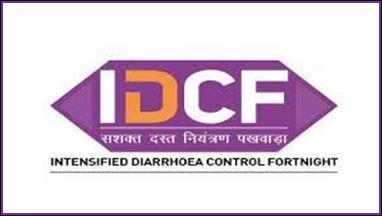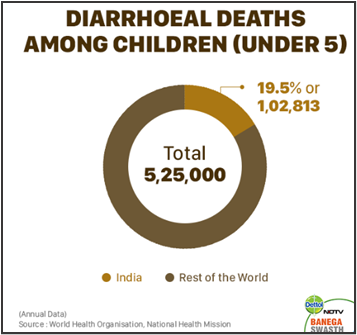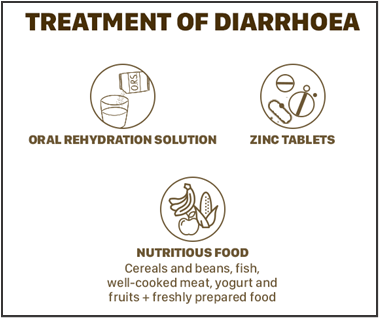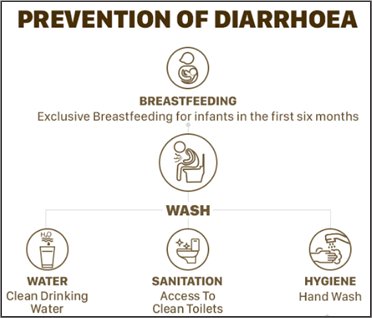DIARRHOEA

Disclaimer: Copyright infringement not intended.
Context
- Union Minister of State for Health and Family Welfare launched the Intensified Diarrhoea Control Fortnight (IDCF)-2022.
Diarrhoea
- As per WHO, Diarrhoea is defined as the passage of three or more loose or liquid stools per day (or more frequent passage than is normal for the individual). It often lasts for a few days and can result in dehydration due to fluid loss.
- The most common cause is an infection of the intestines due to either a virus, bacterium, or parasite—a condition also known as gastroenteritis.
- These infections are often acquired from food or water that has been contaminated by feces, or directly from another person who is infected.
- Diarrhea can be prevented by improved sanitation, clean drinking water, and hand washing with soap.
Status of Diarrhoea
Global
- As per UNICEF report, diarrhoeal diseases account for nearly 1.3 million deaths a year among children under-five years of age making them the second most common cause of child deaths worldwide.
- Diarrhoea is a leading killer of children, accounting for approximately 8 per cent of all deaths among children under age 5 worldwide in 2017- WHO. This translates to over 1,400 young children dying each day, or about 525,000 children a year, despite the availability of a simple treatment solution.
- Over half of the deaths occur in just five countries: India, Nigeria, Afghanistan, Pakistan and Ethiopia.
India
- Diarrhoea is one of the leading causes of deaths in children in this age group globally and claims approximately 1.1 lakh lives in India every year – according to 2019-2020 National Family Health Survey (NFHS-5).
- The National Family Health Survey shows that the prevalence of childhood diarrhoea has increased from 9% to 9.2% from 2016 to 2020 in India. It is the third most common responsible disease for under five mortality.
- According to the latest survey (NFHS-5) conducted by the Ministry, only 60.6% children under the age of five with diarrhoea were given ORS and only 30.5% were given zinc. This means that there is lack of awareness among mothers.
- According to the latest report of SRS-2019, child mortality rate in the country has come down considerably since 2014. This rate has come down from 45 per 1000 live births in 2014 to 35 per 1000 live births in 2019. But even today, diseases related to diarrhoea continue to be a major cause of death in children under the age of five”.
- Dehydration is the biggest cause of diarrhoea in children and other reasons include a change in the baby's diet to make up for a change in the mother's diet when breastfeeding; Use of antibiotics by the baby, or use by the mother while breastfeeding, or any type of bacterial or parasitic infection.

IDCF
- The Intensive Diarrhoea Control Fortnight (IDCF) is being organized since 2014 with an objective to 'bringing the number of deaths due to diarrhoea in childhood to zero'.
- This fortnight is organized especially during summer/monsoon so that preventive measures can be taken.
- IDCF consists of a set of activities to be implemented in an intensified manner for prevention and control of deaths due to dehydration from diarrhoea across all States & UTs. These activities mainly include:
- Intensification of advocacy & awareness generation activities for diarrhoea management,
- Strengthening service provision for diarrhoea case management,
- Establishment of ORS-zinc corners,
- Prepositioning of ORS by asha in households with under-five children and
- Awareness generation activities for hygiene and sanitation.
- One of the main activities under IDCF program has been the activities by field workers including ASHA, ANM and anganwadi workers. Field workers visit the homes of families with children below five years of age and provide counselling in case of diarrhoea for distribution of zinc and ORS sachets. They also promote sanitation practices, breastfeeding practices and advise on preparation method of ORS through group meetings among mothers.

Way Ahead
- Diarrhoea can be prevented through safe drinking water, breastfeeding/appropriate nutrition, hygiene and hygiene measures like hand-washing These small behavioural changes have significantly helped India in reducing infant mortality rate.
- There is a need for more awareness campaigns so that the rate of child mortality due to diarrhoea can be brought down to the minimum level.
- A Multi-sectoral participation approach at various governance levels for better impacts like mass awareness generation, rallies, competitions in schools, State and District level launch by leaders will be beneficial in achieving the target of deaths due to diarrhoea in childhood to zero'.


https://www.pib.gov.in/PressReleasePage.aspx?PRID=1833576



1.png)
